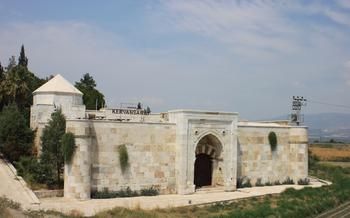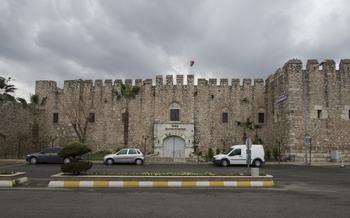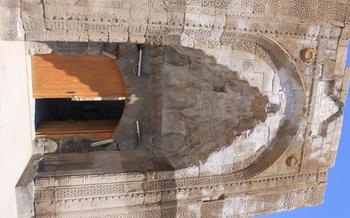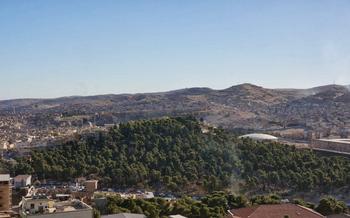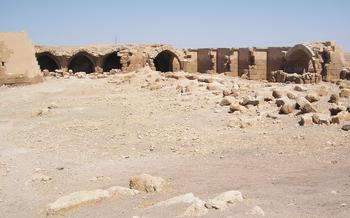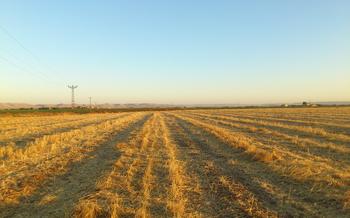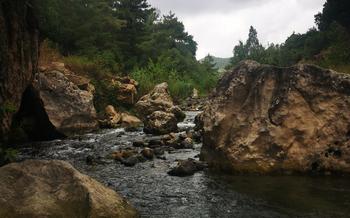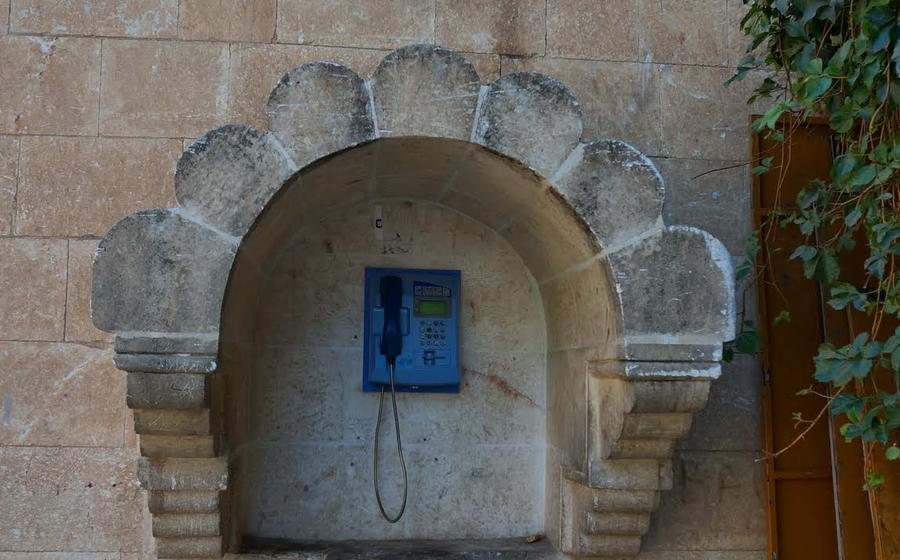
Karahan Caravanserai
- History of the Karahan Caravanserai
- Architecture and Design
- Caravaserai as a Trading Center
- Religious Significance
- Food and Cuisine
- Local Artisans and Crafts
- Surrounding Attractions
- Visitor Information
- Photography and Videography
- Art and Literature Inspired by the Caravanserai
- Modern-Day Renovations and Restoration
- Importance of Sustainable Tourism
- Insider Tip
History of the Karahan Caravanserai
The Karahan Caravanserai, a testament to the rich history of Şanlıurfa, was built in the 13th century during the reign of the Seljuk Sultanate. It stands as a symbol of the region's strategic importance as a trading hub along the Silk Road. The caravanserai's architectural style showcases the blending of Islamic and Anatolian influences, featuring intricate stone carvings, pointed arches, and a central courtyard. Its imposing presence reflects its significance as a resting place for weary travelers, merchants seeking shelter, and a center for cultural exchange.
As caravans laden with exotic goods passed through its gates, the caravanserai hummed with activity. Merchants from distant lands, such as China, India, and Persia, mingled with local traders, exchanging stories, negotiating deals, and forging connections that spanned continents. The caravanserai's walls echoed with the sounds of haggling, laughter, and the clinking of coins, creating a vibrant atmosphere that epitomized the spirit of trade and exploration.
Architecture and Design
The Karahan Caravanserai boasts a unique architectural style that blends traditional Islamic elements with local influences. Constructed using sturdy stone and brick, the caravanserai's exterior features intricate carvings and decorative arches that hint at the opulence within. The central courtyard, a defining feature of caravanserai architecture, is surrounded by two-story buildings with vaulted ceilings and arched openings. The iwans, or large arched recesses, provide shade and shelter from the sun and wind, creating a welcoming space for weary travelers. Each room within the caravanserai is designed to accommodate different types of travelers, from merchants with their goods to families seeking a resting place. The thoughtful design of the caravanserai not only reflects its function as a trading hub but also showcases the architectural prowess of the era.
Caravaserai as a Trading Center
Şanlıurfa, situated on the historic Silk Road, was a major trading hub in the region. The Karahan Caravanserai played a crucial role in facilitating trade and commerce. Merchants from across the region and beyond would gather at the caravanserai to exchange goods, conduct business transactions, and establish partnerships.
The caravanserai was not merely a place of business but also a meeting point for diverse cultures and ideas. Merchants from different countries and backgrounds would come together, sharing stories, experiences, and knowledge. This cultural exchange contributed to the development of new trading routes, the spread of innovative ideas, and the growth of the regional economy.
Some of the goods traded at the caravanserai included textiles, spices, precious stones, and metals. The caravanserai was particularly renowned for its high-quality carpets and textiles, which were produced locally and exported to various parts of the world.
One notable merchant who frequently visited the caravanserai was Marco Polo, the famous Venetian explorer. In his travelogue, Polo described the caravanserai as a bustling center of commerce, where merchants from all over the world gathered to trade their goods. He marveled at the variety of products available, from exotic spices to precious jewels.
The Karahan Caravanserai stands as a testament to the vibrant trading history of Şanlıurfa. Its role as a trading center not only facilitated economic growth but also fostered cultural exchange and understanding, leaving a lasting impact on the region.
Religious Significance
The Karahan Caravanserai served as a significant religious center for Muslim travelers traversing the ancient trade routes. Within the caravanserai's walls, a beautifully adorned mosque stood as a beacon of faith, inviting weary travelers to seek solace and spiritual renewal. The mosque's intricate architecture echoed the caravanserai's grandeur, featuring a spacious prayer hall, an ornate mihrab indicating the direction of Mecca, and delicate calligraphic inscriptions adorning its walls.
Religious rituals and practices were an integral part of life at the caravanserai. Every dawn, the melodious call to prayer reverberated through the courtyard, summoning the faithful to gather for the obligatory prayers. During the holy month of Ramadan, the caravanserai transformed into a hub of spiritual devotion, with communal prayers, Quran recitations, and charitable acts filling the air with an atmosphere of piety and reflection.
One notable anecdote recounts the visit of a revered Sufi saint to the caravanserai. The saint's arrival was met with great reverence, and his presence imbued the caravanserai with an aura of spirituality. He spent days engaging in deep discussions with fellow travelers, sharing his wisdom and guiding them on their spiritual journeys. His teachings left an enduring impact on the caravanserai and its visitors, reinforcing its significance as a place of religious devotion and spiritual growth.
Food and Cuisine
When it comes to food, the Karahan Caravanserai offers a culinary journey that tantalizes the taste buds and showcases the diverse flavors of Turkish cuisine. The caravanserai's restaurant serves a delectable array of traditional Turkish dishes, using fresh, locally sourced ingredients that capture the essence of the region.
One of the must-try dishes is the aromatic testi kebab, a succulent lamb stew slow-cooked in a traditional clay pot. The tender meat falls off the bone and blends harmoniously with the rich flavors of spices and herbs. For a vegetarian delight, the güveç is a tempting casserole of seasonal vegetables, simmered in a flavorful tomato sauce and topped with melted cheese.
Breakfast at the caravanserai is a feast in itself, with a spread of fresh bread, olives, cheeses, and jams. The menemen, a hearty dish of eggs scrambled with tomatoes, onions, and green peppers, is a popular choice among travelers.
As a symbol of Turkish hospitality, the caravanserai offers complimentary çay (tea) to its guests throughout the day. Sip on a refreshing glass of this aromatic beverage while savoring the delectable Turkish delights, known as lokum, which are bite-sized cubes of sweet, chewy confectionery.
The caravanserai's commitment to preserving Turkish culinary traditions is evident in every dish it serves. Whether you're a food enthusiast or simply looking for a satisfying meal, the Karahan Caravanserai offers an unforgettable dining experience that celebrates the rich flavors and warm hospitality of Turkey.
Local Artisans and Crafts
The Karahan Caravanserai is not just a place of historical significance but also a hub for local artisans and craftspeople to showcase their work. Visitors can browse and purchase a variety of traditional handicrafts, including intricate carpets, hand-woven textiles, pottery with unique designs, and gleaming copperware. These artisans often work from small workshops within the caravanserai, allowing visitors to observe their techniques and learn about the rich cultural heritage of the region.
One such artisan is Mehmet, a master carpet weaver who has been practicing his craft for over 40 years. As visitors watch Mehmet's nimble fingers expertly manipulate the colorful threads, he shares stories about the history and symbolism behind each design. Each carpet is a unique work of art, reflecting the cultural heritage of the region and the artisan's personal touch.
For those seeking distinctive jewelry, the caravanserai is home to several silversmiths who create exquisite pieces using traditional techniques. Visitors can admire the intricate filigree work, colorful gemstones, and unique designs that make each piece a treasured keepsake.
By supporting the local artisans at the Karahan Caravanserai, visitors not only take home a piece of Turkish craftsmanship but also contribute to the preservation of traditional skills and cultural heritage. Each purchase helps to sustain the livelihoods of these talented artisans and ensures that their skills continue to be passed down through generations.
Surrounding Attractions
The Karahan Caravanserai is nestled in the heart of Şanlıurfa, a city brimming with historical and cultural treasures. Within easy reach of the caravanserai, visitors can embark on a journey through time, exploring ancient ruins, marveling at architectural wonders, and immersing themselves in the region's rich heritage.
A short stroll from the caravanserai leads to the majestic Şanlıurfa Castle, a formidable fortress that has stood guard over the city for centuries. Its towering walls and imposing gateways beckon visitors to step back in time and imagine the battles and sieges that have shaped its history.
For those seeking a deeper connection with the past, the Şanlıurfa Museum awaits. Housed in a beautifully restored historical building, the museum showcases an impressive collection of artifacts that tell the story of the region's ancient civilizations. From intricate mosaics and pottery to ancient tools and weapons, the museum offers a glimpse into the lives and cultures that have flourished in this land.
Nature enthusiasts will find solace in the nearby Göbekli Tepe, the world's oldest known temple. This awe-inspiring site features a series of mysterious stone circles that predate Stonehenge by thousands of years. As you wander among these ancient structures, you can't help but feel a sense of wonder and connection to the distant past.
These are just a few of the many attractions that await visitors in the vicinity of the Karahan Caravanserai. Whether you seek historical exploration, cultural immersion, or simply the chance to marvel at the wonders of the natural world, the surrounding area offers something for every traveler.
Visitor Information
Planning a visit to the Karahan Caravanserai is a must for anyone traveling to Şanlıurfa. The caravanserai is open to visitors daily, and admission fees are minimal. Guided tours are available for those who want to learn more about the history and architecture of the caravanserai. Visitors can also explore the caravanserai independently and wander through its courtyards, rooms, and mosque.
To make the most of your visit, plan to spend at least a few hours exploring the caravanserai. Allow time to admire the architecture, visit the mosque, and soak up the atmosphere of this historic trading hub. It's also worth trying some of the local dishes and specialties served at the caravanserai, which offer a taste of traditional Turkish cuisine.
For those interested in photography or videography, the Karahan Caravanserai presents a fantastic opportunity to capture stunning images. The caravanserai's unique architecture and picturesque setting provide a beautiful backdrop for photographs and videos. However, it's important to be respectful of other visitors and the sacredness of the site when taking photos or videos.
To ensure a smooth and enjoyable visit, consider the following tips:
- The best time to visit the caravanserai is during the shoulder seasons (spring and autumn) when the weather is pleasant, and there are fewer crowds.
- Wear comfortable shoes, as you'll be doing a lot of walking on uneven surfaces.
- Dress respectfully, as the caravanserai is a religious site.
- Be aware of your surroundings and take precautions to protect your belongings.
- Respect the privacy of other visitors and avoid disturbing those who are praying or meditating.
By following these tips, you can make the most of your visit to the Karahan Caravanserai and create lasting memories of this historic and culturally significant site.
Photography and Videography
The Karahan Caravanserai, with its awe-inspiring architecture and picturesque surroundings, serves as a muse to photographers and videographers alike. The caravanserai's grand facades, intricate carvings, and expansive courtyard offer a myriad of captivating subjects to capture. Whether you're an amateur enthusiast or a professional photographer, the caravanserai provides ample opportunities to create stunning images that encapsulate its historical essence.
To capture the best shots, consider arriving early in the morning or late in the afternoon when the warm, golden light illuminates the caravanserai's stone exterior, casting dramatic shadows that accentuate its architectural details. For interior shots, explore the caravanserai's atmospheric iwans, where the play of light and shadow creates a sense of depth and mystery.
Respect for other visitors and the sacredness of the site is paramount. Be mindful of ongoing activities and avoid disrupting religious rituals or blocking pathways. If you wish to photograph individuals, always ask for their permission beforehand.
Capture the essence of the caravanserai's vibrant spirit by photographing the interactions between travelers, merchants, and artisans. Document the bustling atmosphere of the courtyard, where conversations, laughter, and the clinking of coins create a symphony of sounds. Preserve the memories of traditional performances, where dancers twirl to the rhythm of enchanting melodies, and storytellers weave tales that transport listeners to distant lands.
Through your lens, share the beauty and significance of the Karahan Caravanserai with the world, inspiring others to embark on their own journey of discovery and appreciation for this architectural masterpiece.
Art and Literature Inspired by the Caravanserai
The Karahan Caravanserai has captured the imagination of artists, writers, and poets throughout history. Its unique architecture, rich history, and cultural significance have served as inspiration for a variety of creative expressions.
One of the most famous literary works inspired by the caravanserai is the novel "The Forty Days of Musa Dagh" by Franz Werfel. The novel tells the story of an Armenian community that takes refuge in the caravanserai during the Armenian Genocide. Werfel's vivid descriptions of the caravanserai and its surroundings bring the historical site to life for readers.
The caravanserai has also been a muse for visual artists. Many paintings, drawings, and photographs have been created depicting the caravanserai's architectural beauty and its role as a hub of trade and culture. These artworks capture the essence of the caravanserai and allow viewers to experience its grandeur and historical significance.
In addition to novels and paintings, the caravanserai has also inspired poetry and music. Poets have written verses about the caravanserai's history, architecture, and cultural significance. Musicians have composed songs that evoke the atmosphere and spirit of the caravanserai.
These creative expressions not only showcase the artistic and cultural value of the Karahan Caravanserai but also contribute to its enduring legacy. They help to preserve the memory of this historic site and ensure that its story continues to be told for generations to come.
Modern-Day Renovations and Restoration
The Karahan Caravanserai has undergone meticulous renovations and restoration efforts to ensure its preservation for future generations. These endeavors have required extensive research, careful planning, and skilled craftsmanship. The goal has been to maintain the caravanserai's historic integrity while addressing the need for modern amenities and safety features.
One of the main challenges faced during the restoration process was the need to strike a balance between preserving the caravanserai's original character and implementing necessary updates. This involved repairing damaged structures, restoring intricate carvings and decorations, and incorporating modern elements that blend seamlessly with the historic architecture.
Artisans and craftsmen specializing in traditional techniques were employed to ensure that every detail of the caravanserai was restored with precision and authenticity. The use of local materials and construction methods further contributed to the preservation of the site's cultural heritage.
The result of these painstaking efforts is a beautifully restored caravanserai that retains its historic charm while offering modern amenities. Visitors can now explore the caravanserai's courtyards, iwans, and rooms, marvel at its intricate architectural details, and immerse themselves in its rich history.
Anecdotes:
-
During the restoration process, a hidden chamber was discovered beneath the caravanserai's courtyard. This secret chamber is believed to have been used as a treasury or storage space during the caravanserai's heyday.
-
A team of skilled artisans spent months painstakingly restoring the caravanserai's intricate stone carvings, which had been damaged over time by weather and neglect. The result is a stunning testament to the craftsmanship of the past.
-
The restoration of the caravanserai has breathed new life into this historic site, attracting visitors from around the world who come to admire its beauty and learn about its fascinating history.
Importance of Sustainable Tourism
The Karahan Caravanserai, with its rich history and cultural significance, is a treasure that must be preserved for future generations. Sustainable tourism practices play a crucial role in ensuring the caravanserai's longevity and protecting the environment around it. Here are a few ways visitors can contribute to sustainable tourism at the caravanserai:
-
Respect the Local Environment: Minimize your ecological footprint by conserving water and energy during your stay. Dispose of waste responsibly and avoid littering to preserve the natural beauty of the surroundings.
-
Support Local Businesses: Choose to shop at local markets and support small businesses in the area. This helps sustain the local economy and promotes cultural preservation.
-
Be Mindful of Cultural Sensitivity: Show respect for the local customs and traditions. Dress appropriately, be mindful of noise levels, and seek permission before taking photographs of people.
-
Engage in Responsible Activities: Choose activities that are environmentally friendly and do not harm the surrounding ecosystem. Opt for guided tours that prioritize sustainability and conservation.
By embracing sustainable tourism practices, visitors can help protect the Karahan Caravanserai and its surroundings, ensuring that it remains a vibrant and welcoming destination for years to come. Every traveler has a responsibility to contribute to the preservation of this historical gem.
Insider Tip
Amidst the captivating wonders of the Karahan Caravanserai, there lies a hidden gem that often eludes the attention of casual visitors. Tucked away in a secluded corner of the courtyard, a small, unassuming door leads to a hidden chamber, a secret sanctuary that whispers tales of bygone eras.
Step inside, and you'll be transported back in time, to a world where merchants and travelers from distant lands exchanged stories and dreams under the soft glow of oil lamps. The air is still heavy with the scent of spices and exotic perfumes, a testament to the vibrant trade that once flourished within these walls.
In this hidden chamber, you can marvel at intricately carved stone niches, each one telling a silent story of the people who passed through this caravanserai centuries ago. Touch the cool, worn surfaces, and feel the weight of history in your fingertips.
As you explore this secret sanctuary, let your imagination soar. Picture the caravanserai bustling with activity, the courtyard echoing with the laughter and chatter of weary travelers seeking respite and camaraderie. Imagine the merchants haggling over prices, the clinking of coins, and the rustle of silks and spices.
In this hidden chamber, you'll discover a hidden treasure, a glimpse into the rich tapestry of the caravanserai's past. It's a place where history comes alive, where the echoes of the past still linger, waiting to be heard by those who seek to listen.
